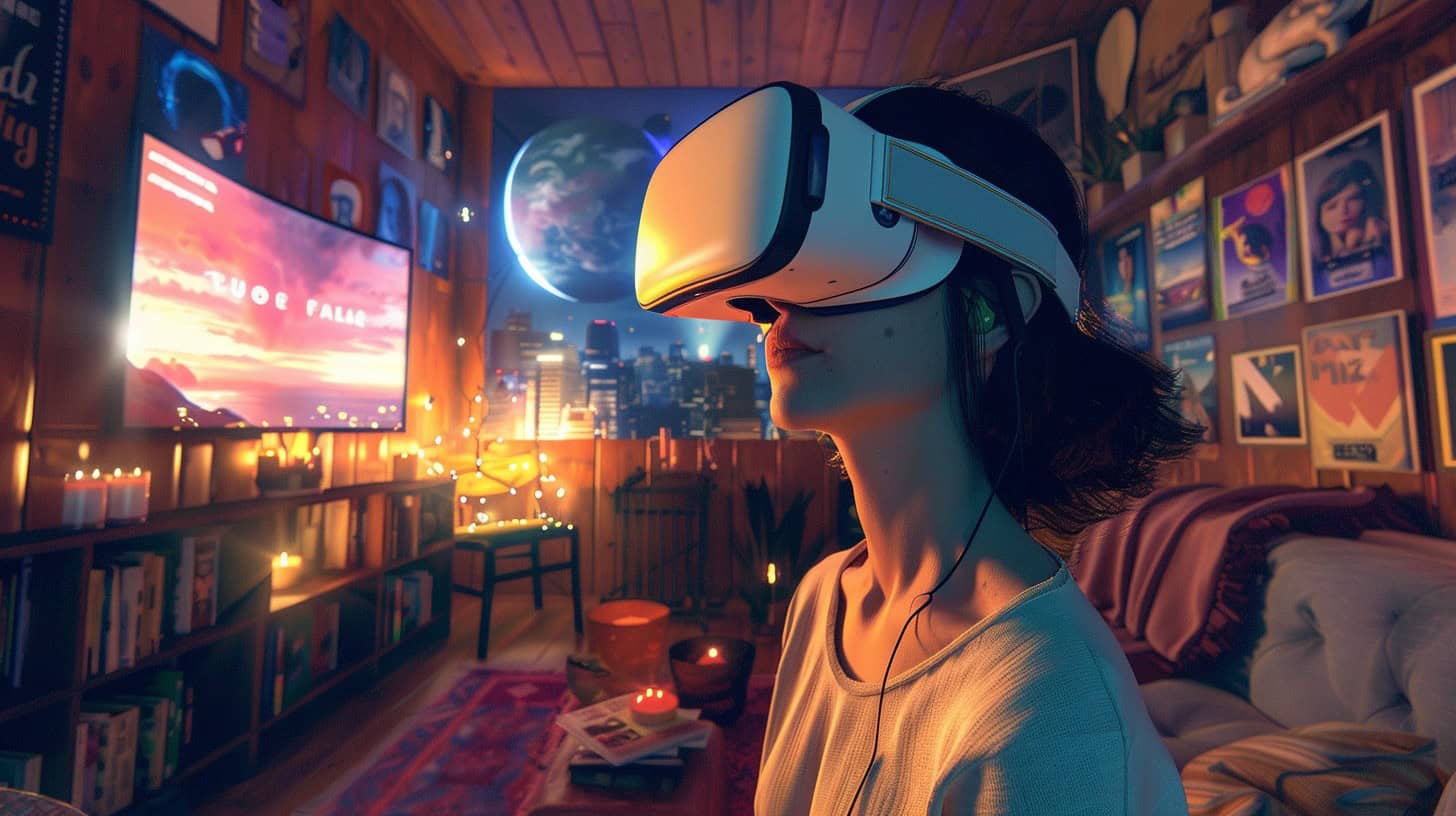Wondering if you can watch movies with virtual reality? The surge in app downloads for Meta (Oculus) Quest 2 during the holiday season says yes. Our guide shows how to turn this possibility into a thrilling reality.
Get ready – your movie nights are about to transform!
Key Takeaways
You can watch movies in virtual reality (VR) using headsets like Meta Quest 2 and HTC Vive. These gadgets let you feel as if you’re inside the movie.
VR technology changes how we experience films by putting us in the middle of the action or a virtual cinema, making it more immersive than traditional screens.
Services like Netflix and Prime Video have VR apps that allow watching movies in a specially designed virtual environment. Other platforms like Bigscreen enable streaming from your computer to your VR device.
Watching movies in VR can make some people feel dizzy or sick because your eyes see moving images, but your body doesn’t move. It helps to start with short sessions and get used to it gradually.
To enjoy movies in VR, you need a compatible headset, and depending on what you want to watch, there might be costs for equipment, subscription services, or movie rentals.
Table of Contents
Exploring Virtual Reality (VR) Technology
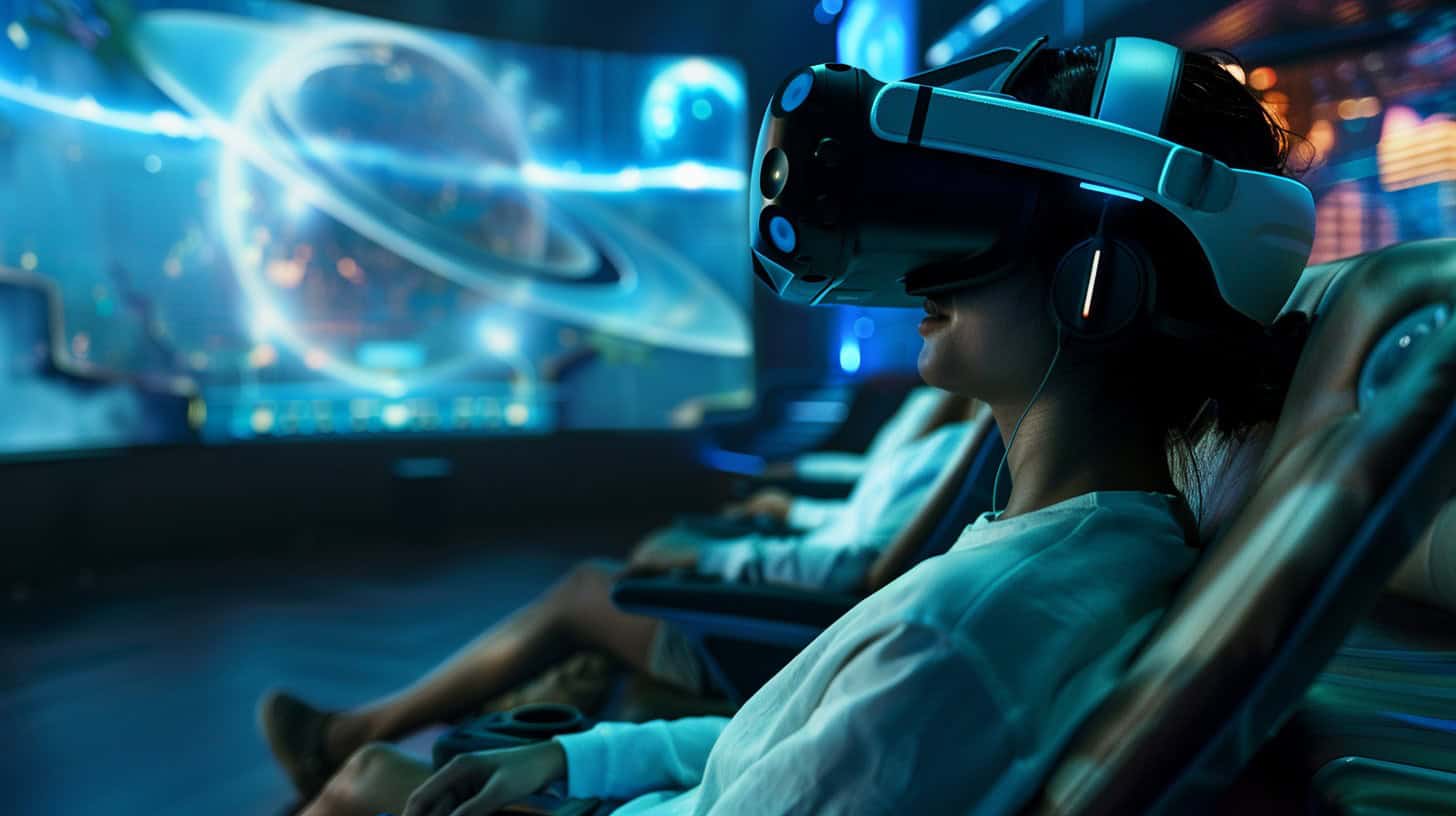
Virtual reality (VR) technology pulls you into movies like no flat screen can. VR headsets, such as the Meta Quest 2 and HTC Vive, act as your ticket to this immersive world. With these devices on your head, you stand in the center of the action—looking around as if you were really there.
Popular downloads during holidays show many are jumping on board.
Streaming services have adapted too. Netflix and Prime Video offer apps for VR enjoyment, bringing cinema to life in virtual rooms designed just for viewers. Bigscreen lets users stream video-on-demand through YouTube or directly from their computer with a Remote Desktop Client setup that takes mere minutes but changes movie nights forever.
With VR, every movie night is an adventure waiting to happen.
The Virtual Reality Cinema Experience
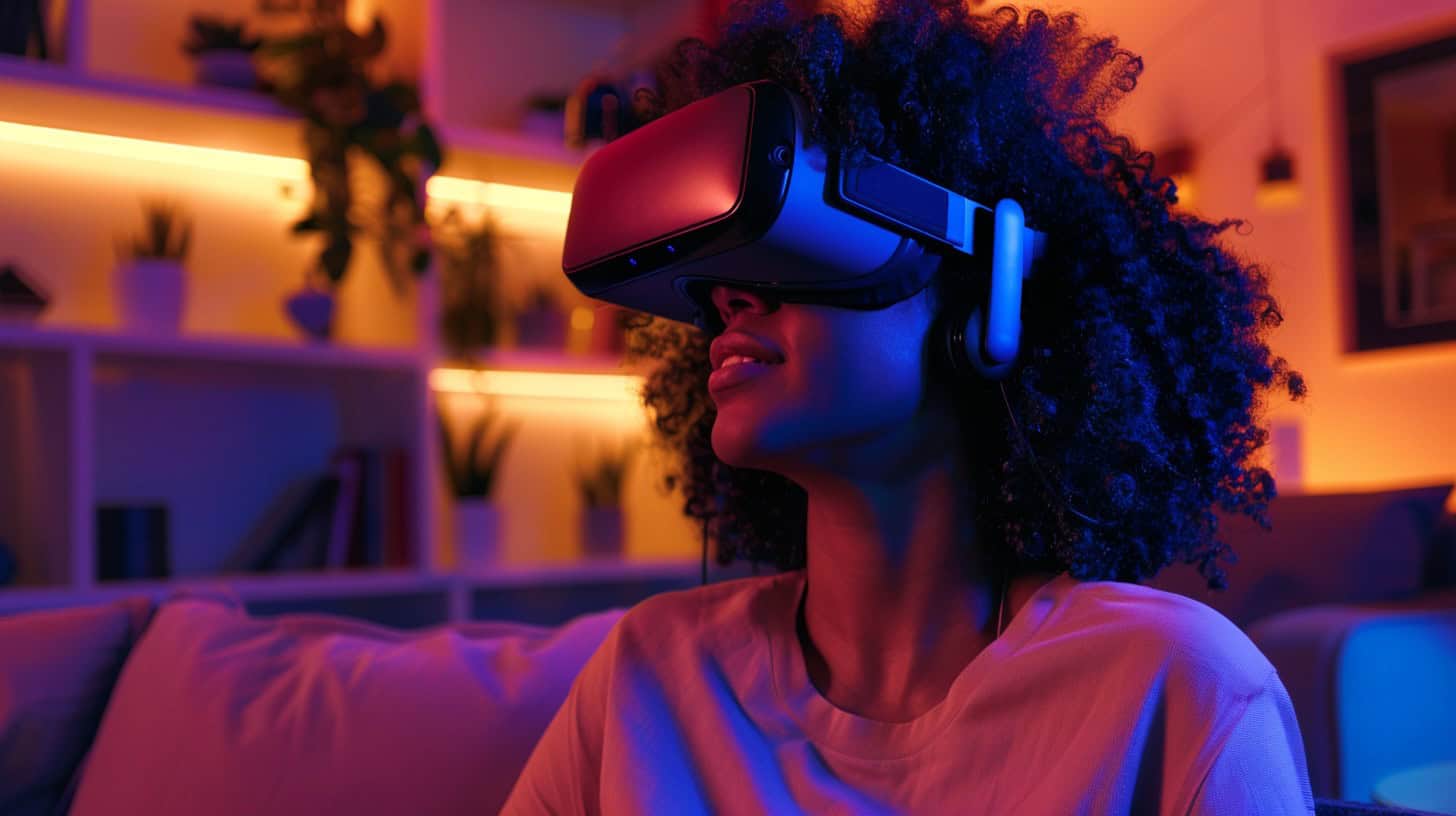
Jump into movies like never before with virtual reality. It’s like stepping right inside the story, thanks to VR technology and immersive films that change how we watch.
Immersion in VR Movies
VR movies take you right into the action, making you feel like you’re part of the story. Imagine sitting in a virtual cinema, but instead of watching on a simple 2D screen, everything happens around you in 360 degrees.
This journey begins with putting on VR goggles and selecting a movie from apps like Oculus Store or Google Play. Suddenly, settings that were once distant – space stations, deep oceans, even first person porn sites – wrap around you.
I tried this with an Oculus Quest 2 headset, and it was unlike any movie night before. One minute, I’m looking at stars above me; next thing I know, characters are passing by as if they’re real people in my living room.
It’s not just about watching; it’s about feeling present in another world. You aren’t just observing; it feels personal because everything plays out as if tailored for you alone.
Plus, setting up didn’t take long. A few tools here and there – VR goggles ready and connected to my Android device through an app – then off to immersive adventures without leaving home.
Evolution from 3D to Virtual Environments
Movies have come a long way, moving from simple 2D to eye-popping 3D. Now, we step into virtual environments with VR headsets. These gadgets let us dive into stories as if we’re part of them.
It’s like the difference between looking through a window and walking around inside the story world. Oculus Rift and HTC Vive made this jump possible.
Before, watching a movie meant staring at a flat screen. Today, Meta Quest 2 puts you in a cinema that only exists in digital space. You can look around and feel like you’re really there.
This change gives viewers new ways to experience movies beyond what IMAX or Blu-rays offer.
Watching films is no longer just about seeing but being part of the story.
Now let’s get ready for what gear you need to watch VR movies.
Necessary Gear for VR Movie Watching
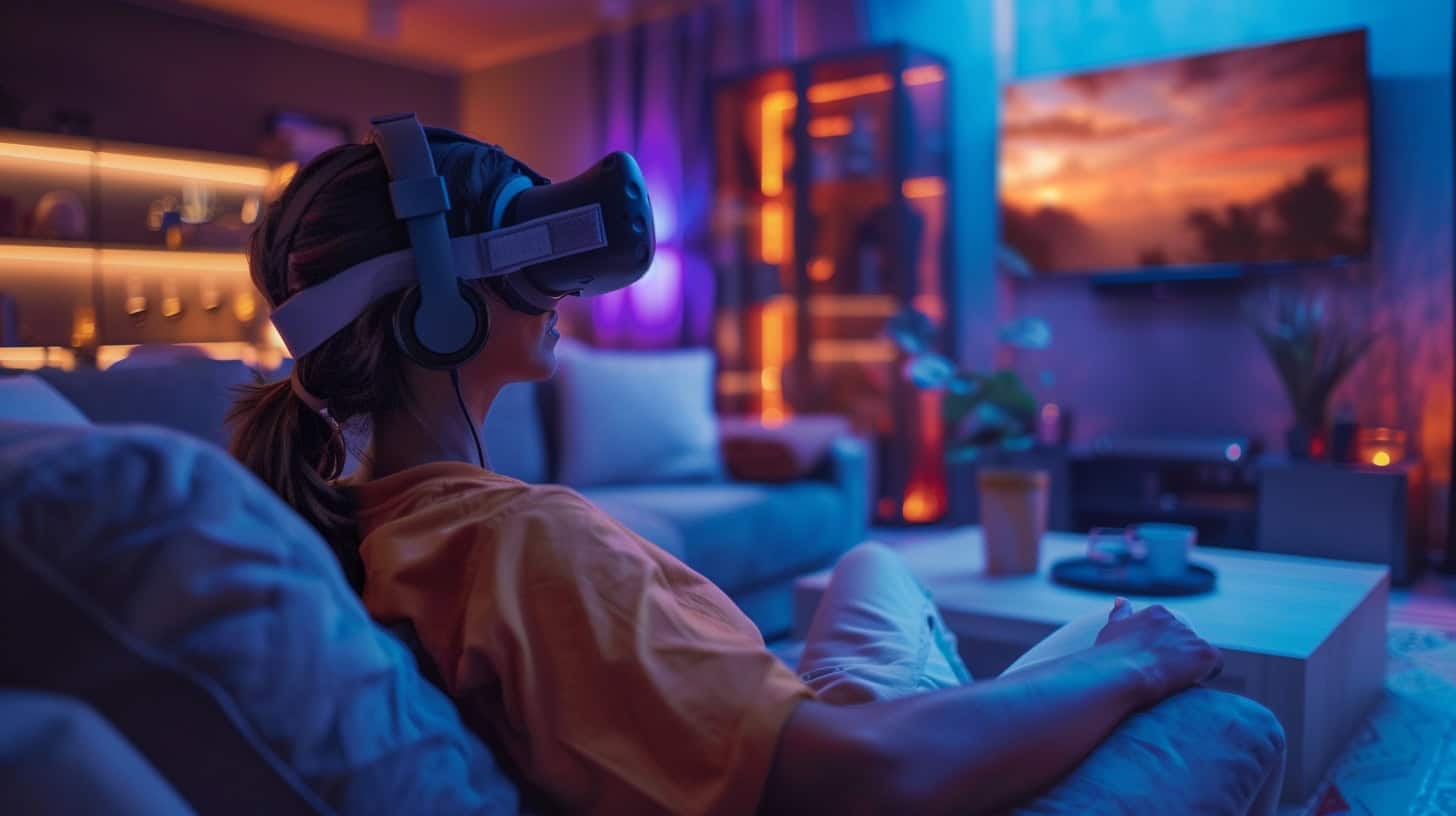
For VR movie watching, you must have the right tools. This means grabbing a virtual reality headset, like Quest 2 or Samsung Gear VR.
The Role of VR Goggles
VR goggles are key for watching movies in a whole new way. These devices transform your viewing from flat screens to 360-degree worlds where stories unfold all around you. I tried it with a Quest 2 headset, and the difference is night and day compared to regular TV or cinema.
You wear these goggles just like glasses, but instead of lenses, they have screens that show the movie.
My experience showed me that features like resolution and head tracking matter a lot. High resolution makes everything look crisp, while good head tracking keeps the movie steady as you move your head.
Models like Samsung Gear VR, Valve Index, and Google Cardboard cater to different needs and budgets. Each has its specs that affect how well you can dive into virtual cinemas or play games like Beat Saber.
They’re not just for solo fun; some apps let friends join in remotely for movie nights through platforms like Oculus TV or Bigscreen.
Overview of VR Android Goggle Sets
Moving beyond the basic role of VR goggles, let’s explore VR Android goggle sets. These devices connect to your Android phone, turning it into a virtual reality experience. They’re perfect for movie fans who want to dive into films like never before.
I’ve tried several sets and found that they vary in comfort, quality, and price.
Some popular models include the Google Daydream View and Samsung Gear VR. With these sets, users download apps from the Google Play Store or use specific media players like Netflix or Hulu that have a virtual environment option.
For instance, watching a movie on Netflix through a Samsung Gear VR can make you feel like you’re sitting in an actual theater.
Using my own Samsung Gear VR, movies became more than just watching; they were experiences.
Each set has its unique features—like head tracking accuracy or screen resolution—but all aim to give you an immersive viewing time. You’ll need an Android app or access services like Vimeo or YouTube App designed for virtual reality to start watching movies.
Some sets also support technical tools as Oculus Rift DK2 does for PCs but made simple for mobile use.
Insights into Quest 2 VR Headset
The Quest 2 headset from Meta (Oculus) has become a top choice for virtual reality fans. With its surge in app downloads, more people are using it to step into different worlds. This device lets users watch movies in a new way, placing them inside a virtual cinema.
You can stream films through apps like Netflix and Prime Video directly on the headset. For those with videos on their computer, setting up Bigscreen only takes minutes.
Quest 2 caters to both VR veterans and newcomers. Its easy setup means you’ll be ready to go quickly. Next, find out how to choose the best movie apps for your VR experience.
Steps to Enjoy Movies in VR
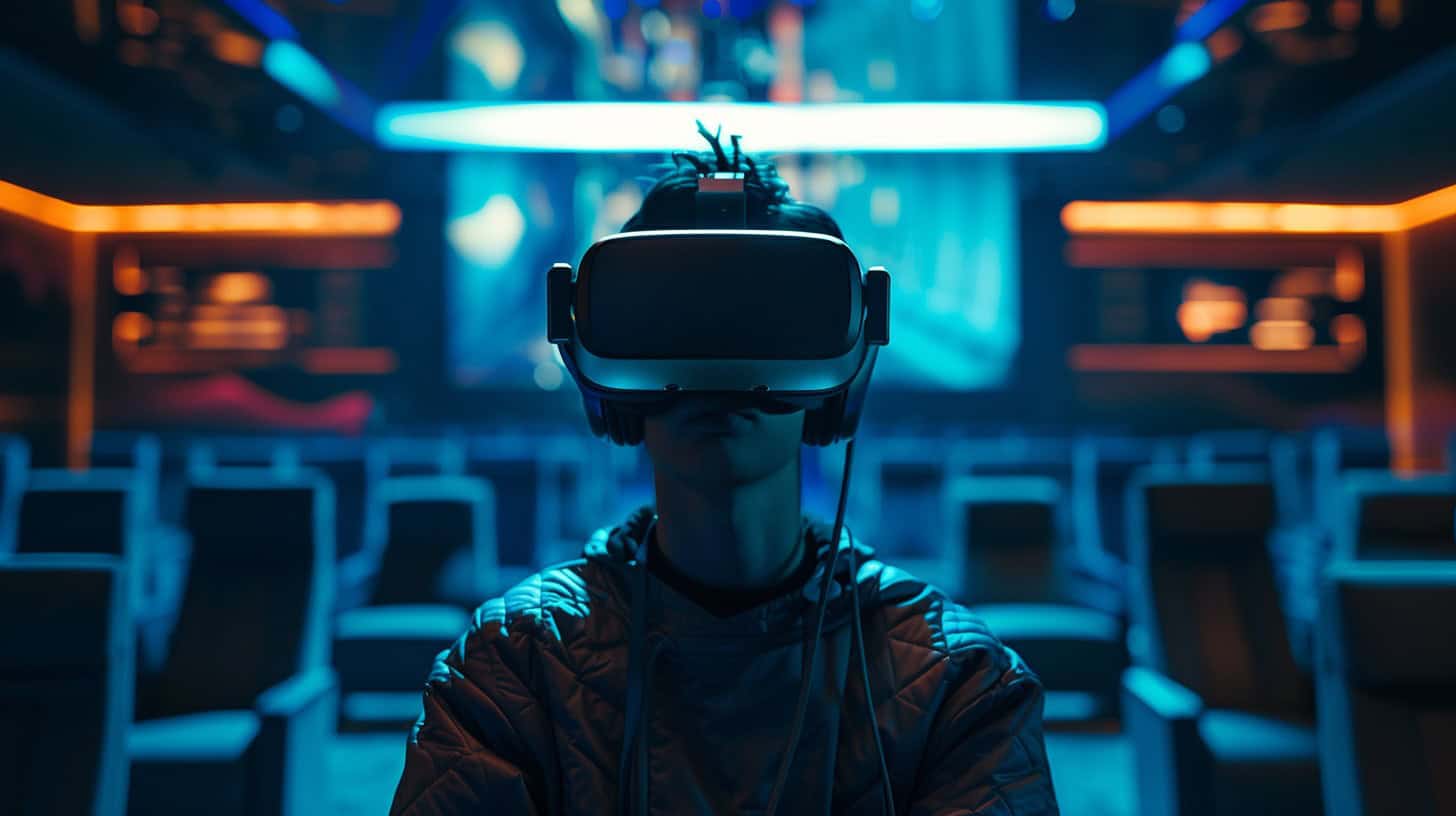
Choosing the right VR movie app starts your adventure. Get your VR gear ready, like Quest 2 or Vive headsets. Then, jump into a movie with just a few clicks. Ready to try?
Selecting the Ideal VR Movie App
Picking the right VR movie app depends on what you like. Netflix and Prime Video are good for Quest users. They make it easy to watch shows with a click. For fans of YouTube or renting movies, Bigscreen and similar platforms offer simple steps to enjoy videos.
This means comfort in finding something that fits your taste.
I tried several apps on my HTC Vive, considering choices good for both HTC Vive and Valve Index users. The key is ease of use and having lots of options. Some apps also let you watch movies with friends who have headsets too, making the experience fun and shared, no matter where you are.
Always check if the app has your favorite movies and how easy it is to set up your gear before diving in.
Preparing Your VR Equipment
After choosing a VR movie app, it’s time to get your VR equipment ready. First, make sure your Meta (Oculus) Quest 2 or other headsets like HTC Vive are fully charged. A low battery can cut your movie experience short.
Next, check all the cables. For offline viewing with the Bigscreen app, connect your headset to a PC using the charging cable. This setup allows streaming movies stored on the computer directly into the VR environment.
Ensure your play area is clear of obstacles to avoid accidents while moving around during immersive scenes. Adjust the straps of your headset for comfort—tight enough to stay in place, but not so tight that it hurts.
Finally, if you’re using external headphones for better sound quality, plug them in before starting your movie. These steps will help create an enjoyable and seamless VR cinema experience at home.
Initiating Your VR Movie Experience
To start watching movies with your VR headset, first, pick a comfortable spot. Make sure it’s quiet and you won’t be disturbed. Then, choose the right app for movies. Netflix and Prime Video work great on Quest 2 headsets.
They have their apps in the store.
Next, put on your VR goggles. Check if they’re charged and working well. Open the movie app you like—let’s say Netflix—and log in. If you’re new, sign up first. Find a movie to watch.
It could be anything from Amazon Prime or HBO Max choices.
Now, adjust your seat and headphones for good sound. Play the movie and enjoy! In my experience, using Bigscreen to stream video files from my computer makes home viewing special.
Remember, for streaming services not directly available on Quest 2—like YouTube or Plex—you might need extra steps, but it’s simple once you get the hang of it.
The Dual Sides of VR Movie Watching
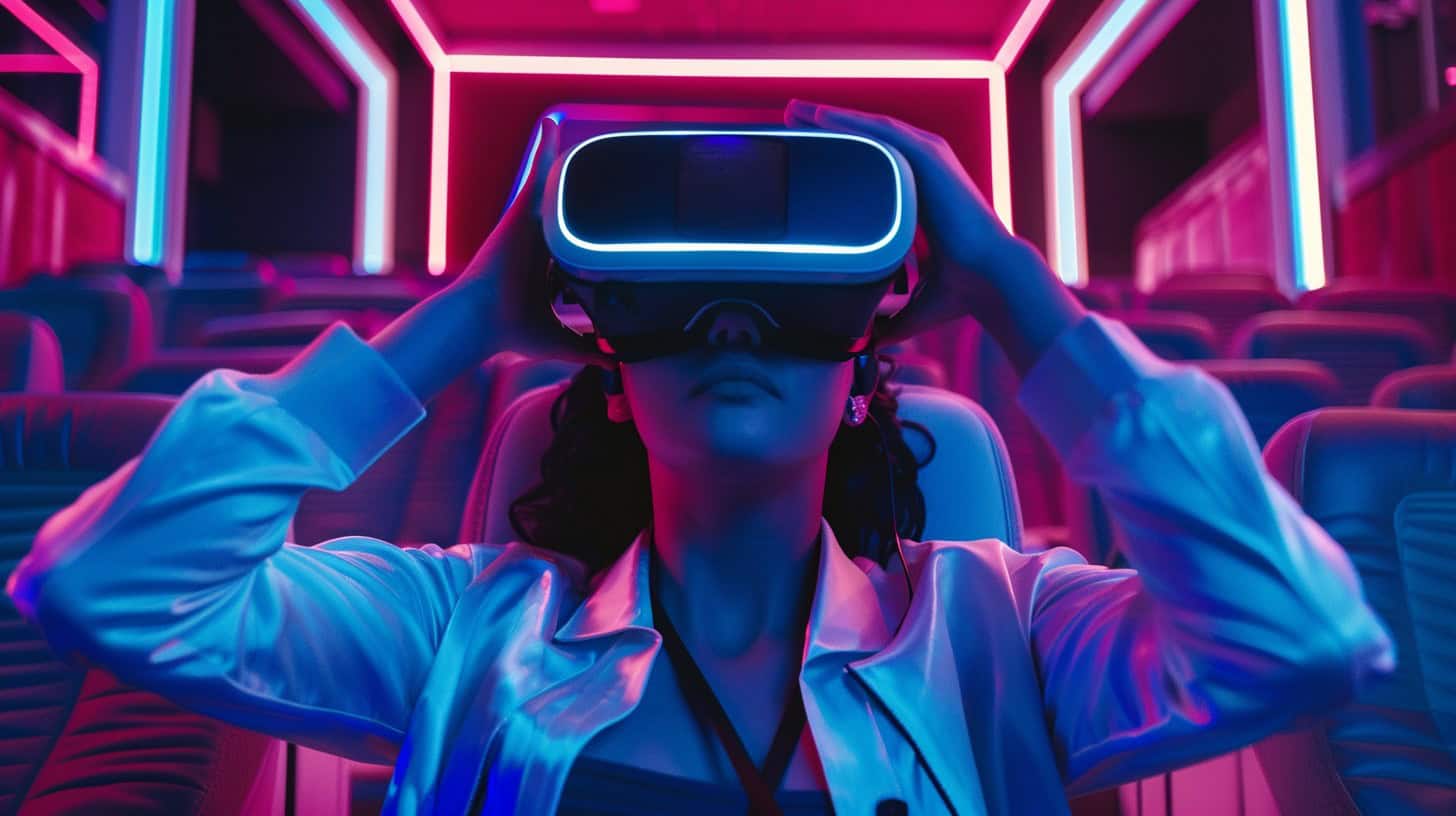
Watching movies through VR brings you face to face with two worlds. You get sucked right into the action, but sometimes, your head might not feel too good after.
The Draw of Immersion
Movies in VR pull you into stories like never before. You sit in a virtual room or cinema, but the feeling is different. The screen ahead feels huge, wrapping around your view. It’s like being at a premium movie theater from your couch.
This setup gives you the best seat every time.
VR turns simple movie nights into adventures. Imagine watching action scenes unfold all around you, or standing beside characters as they speak. Websites of streaming services open right in your VR through browsers like Firefox Reality, making it easy to jump into diverse worlds without leaving home.
This experience changes how we enjoy films, making each viewing unique and thrilling.
Navigating Potential Discomfort
Some people feel sick using VR headsets. This happens because your eyes see moving images, but your body stays still. It’s like reading in a car. Your brain gets mixed signals, leading to discomfort or nausea.
The best way is to start slow with short sessions and gradually increase time as you get used to it.
Using the Quest 2 for movies, I noticed fewer issues over time. Setting up a comfortable space helps too. Make sure there’s good ventilation and enough room to move slightly without hitting anything.
If you feel dizzy or have headaches, take off the headset and rest. Over time, most users find their sea legs in virtual environments with less trouble.
Assessing Accessibility and Expenses
Accessing VR movies is straightforward. Expenses vary. Here’s a brief look:
| Aspect | Details |
|---|---|
| VR Headsets | Prices range widely. Quest 2, a popular choice, starts around $299. Android VR goggle sets can be more affordable. |
| Movie Apps | Some apps are free. Netflix and Prime Video require subscriptions. Prices vary by plan. |
| Movie Rentals | Video-on-demand on platforms like YouTube may cost $3-$20 per movie, depending on release date and quality. |
| Setup | Setting up a Remote Desktop Client for streaming from a computer is free, but requires a compatible VR headset. |
| Streaming Workarounds | Accessing streaming services via a browser in VR is possible; no extra charges apply beyond your existing subscriptions. |
To watch movies in VR, you need the right equipment and apps. Some are free, others are not. Prices for VR headsets like the Quest 2 start at about $299. Movie apps may cost you a subscription fee. Renting a movie can range from $3 to $20. You can set up a desktop client for VR movie watching at no extra cost. Using a browser in VR to watch movies does not add additional charges.
Top Picks for VR Movie Applications
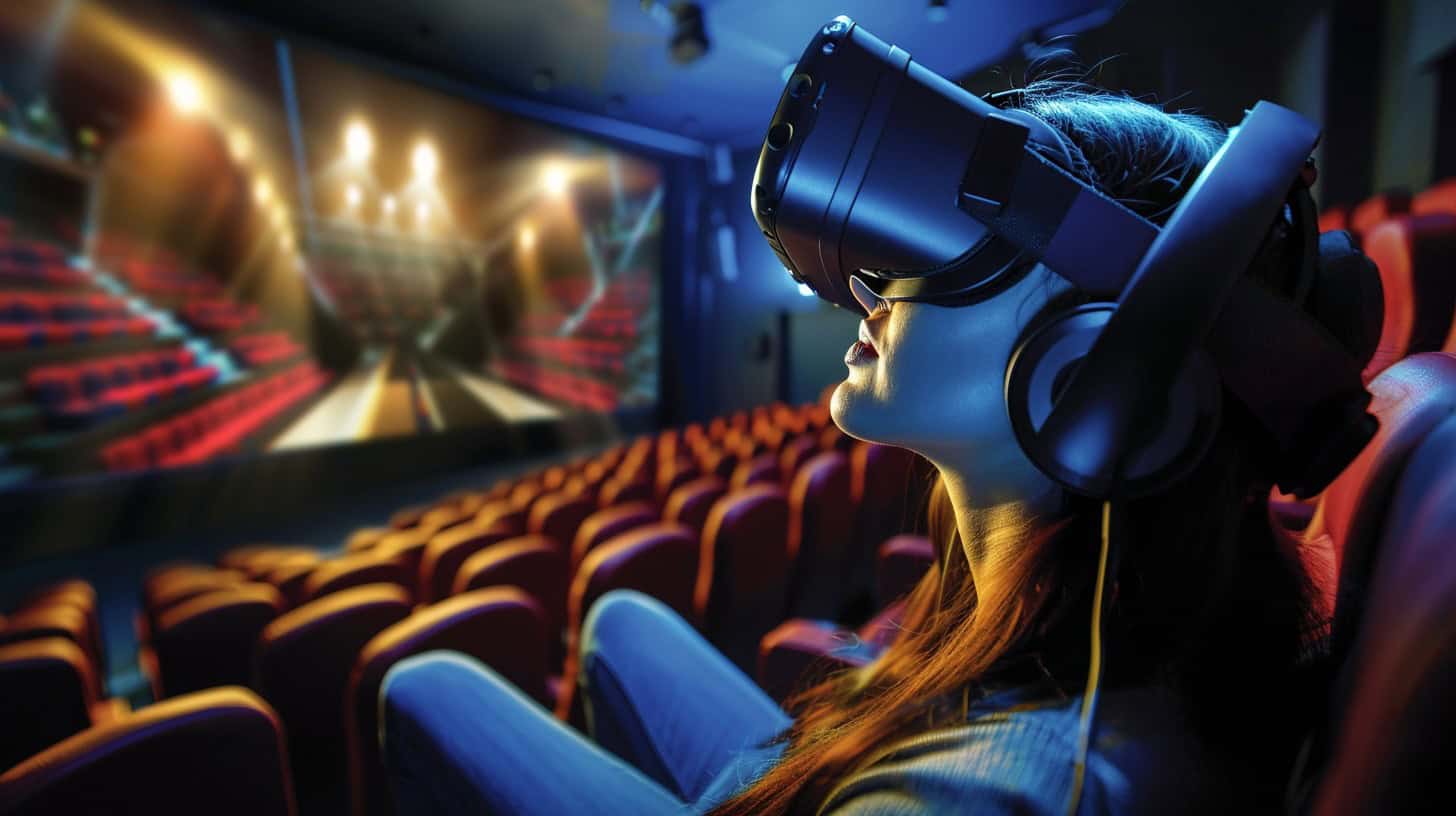
Choosing the right VR movie app changes everything. It turns your living room into a cinema. Here are the top picks, fully explained:
- Netflix VR offers a vast library of movies and shows right at your fingertips. Watch in a virtual room that feels like home.
- Prime Video VR brings Amazon’s collection into virtual reality. Enjoy thousands of titles across various genres.
- YouTube VR is free and full of endless content. Discover videos from around the globe in 360 degrees.
- Bigscreen lets you stream your computer’s video files directly to your headset with Remote Desktop Client set up.
- Hulu VR adds another layer to watching TV shows and movies by placing you in immersive environments.
- Paramount Plus can be accessed through web browsers in VR, offering a wide range of movies and exclusive content.
- Firefox Reality, designed for browsing websites in VR, works well for streaming services like HBO Max and Hulu, providing a more reliable video playback experience.
Each app has unique features that cater to different tastes and preferences, ensuring there’s something for every geek out there looking for an immersive cinematic adventure.
FAQs About Watching Movies with Virtual Reality
Can I watch movies with a VR headset, like Quest 2?
Yes! With a VR headset, such as the Quest 2, you dive into movies in a whole new way. It’s not just watching; it’s living the scene.
Do I need special apps or tools to play movies in VR?
You bet. Use apps like Virtual Desktop or VLC player… They let you stream or play downloaded movies right inside your virtual space.
Is it possible to watch any movie in VR, even if it’s not made for VR?
Sure thing! While some films are made for VR, you can watch regular movies too. They’ll appear on a big screen in your virtual cinema.
What about watching with friends? Can we do that in VR?
Absolutely! Platforms exist where you and your geeky buddies can gather in a virtual room… Think of it as your private bat cave for movie nights.
Any tips for making my movie-watching experience better in VR?
Oh, yeah—comfort is key! Get cozy before you boot up, and maybe invest in technical support gear if needed… Like an OLED Switch or Vive VR for top-notch visuals.
